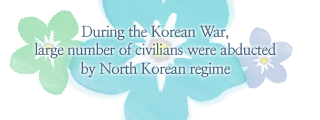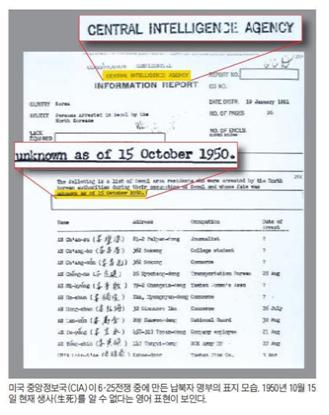Name: admin
2014-01-16 12:27:11 | Hit 6742
Mar. 7, 2013
Chosun Daily
“Oldest Known Register of War Abductees Found”
In the aftermath of the breakout of the Korean War in 1950, the CIA created a register of South Koreans abducted from the greater Seoul area, it has been revealed.
The CIA created the list on October 15th, 1950, right after the recapture of Seoul by allied forces on September 28th, 1950. The register was uncovered at the United States’ National Archives and Records Administration (NARA) and made available to the public on the 6th by the Korean War Abductees’ Family Union (KWAFU).
The register, entitled, “Persons Arrested in Seoul by the North Koreans,” contains the names of 654 abductees in alphabetical order.
It was further noted that the fate of the persons was unknown at the date of publishing. The register itself was distributed on January 19th, 1951.
The 26-page register primarily lists the names of abductees of high social ranking. A Lawmaker with the provisional South Korean government, Kim Sang Sok, was listed as abducted on July 20th. Kim, who also served as the Minister for Culture for the provisional government, also served as the principal of Gyeongshin Middle School.
Also listed is Lee Joo Shin, a former Chief Prosecutor at the Seoul District Prosecutor’s Office who resided in the Changsin neighborhood of Jongro, Seoul. His date of abduction was August, 1950.
AhnByung Hun, the son of registered abductee Ahn Chan Soo, said of the list, “The home address where I lived with my father was 81-2 Palpan-dong, Jongro, Seoul. I was very surprised that it had been correctly recorded on the CIA register in English. I suppose the United States prepared it in order to hold North Korea accountable for the outbreak of the war and the abductions.”
Prior to the release of the CIA register, the “Seoul City Victim Register” held at South Korea’s Department of Public Information was thought to be the oldest in existence. That register was drawn up on December 1st, 1950. The discovery of this new register created approximately six weeks prior will be highly valuable when approaching North Korea with the issue of wartime abductees. That the register was created by a third country is also of great interest.
In particular, this CIA register contained a list drawn up after abductees had been interrogated by the North Korean authorities, so there is a strong possibility that it had been rewritten.
In addition, in contrast to the partial or writing in full of abductees addresses like in the ‘Seoul City Vicitm Register’, the CIA list wrote down the numbers of the houses, showing that it did not refer to the list made by the South Korean government. Based on these facts, the Korean Abductees’ Family Union are presuming that it was translated by the Americans into English and produced after a list was made in Seoul and Pyongyang after the September 28th recapture of Seoul.
KWAFU President Lee MiIl said, “This register was made not by a direct victim country of the war but by a third party, the United States, so it may be more objective. Even though a lot of time has passed, the government and international community must use this register and firmly push the issue of wartime abductees with North Korea.”
Chosun Daily
“Oldest Known Register of War Abductees Found”
In the aftermath of the breakout of the Korean War in 1950, the CIA created a register of South Koreans abducted from the greater Seoul area, it has been revealed.
The CIA created the list on October 15th, 1950, right after the recapture of Seoul by allied forces on September 28th, 1950. The register was uncovered at the United States’ National Archives and Records Administration (NARA) and made available to the public on the 6th by the Korean War Abductees’ Family Union (KWAFU).
The register, entitled, “Persons Arrested in Seoul by the North Koreans,” contains the names of 654 abductees in alphabetical order.
It was further noted that the fate of the persons was unknown at the date of publishing. The register itself was distributed on January 19th, 1951.
The 26-page register primarily lists the names of abductees of high social ranking. A Lawmaker with the provisional South Korean government, Kim Sang Sok, was listed as abducted on July 20th. Kim, who also served as the Minister for Culture for the provisional government, also served as the principal of Gyeongshin Middle School.
Also listed is Lee Joo Shin, a former Chief Prosecutor at the Seoul District Prosecutor’s Office who resided in the Changsin neighborhood of Jongro, Seoul. His date of abduction was August, 1950.
AhnByung Hun, the son of registered abductee Ahn Chan Soo, said of the list, “The home address where I lived with my father was 81-2 Palpan-dong, Jongro, Seoul. I was very surprised that it had been correctly recorded on the CIA register in English. I suppose the United States prepared it in order to hold North Korea accountable for the outbreak of the war and the abductions.”
Prior to the release of the CIA register, the “Seoul City Victim Register” held at South Korea’s Department of Public Information was thought to be the oldest in existence. That register was drawn up on December 1st, 1950. The discovery of this new register created approximately six weeks prior will be highly valuable when approaching North Korea with the issue of wartime abductees. That the register was created by a third country is also of great interest.
In particular, this CIA register contained a list drawn up after abductees had been interrogated by the North Korean authorities, so there is a strong possibility that it had been rewritten.
In addition, in contrast to the partial or writing in full of abductees addresses like in the ‘Seoul City Vicitm Register’, the CIA list wrote down the numbers of the houses, showing that it did not refer to the list made by the South Korean government. Based on these facts, the Korean Abductees’ Family Union are presuming that it was translated by the Americans into English and produced after a list was made in Seoul and Pyongyang after the September 28th recapture of Seoul.
KWAFU President Lee MiIl said, “This register was made not by a direct victim country of the war but by a third party, the United States, so it may be more objective. Even though a lot of time has passed, the government and international community must use this register and firmly push the issue of wartime abductees with North Korea.”






















 FAX : (82)31-930-6099
FAX : (82)31-930-6099
